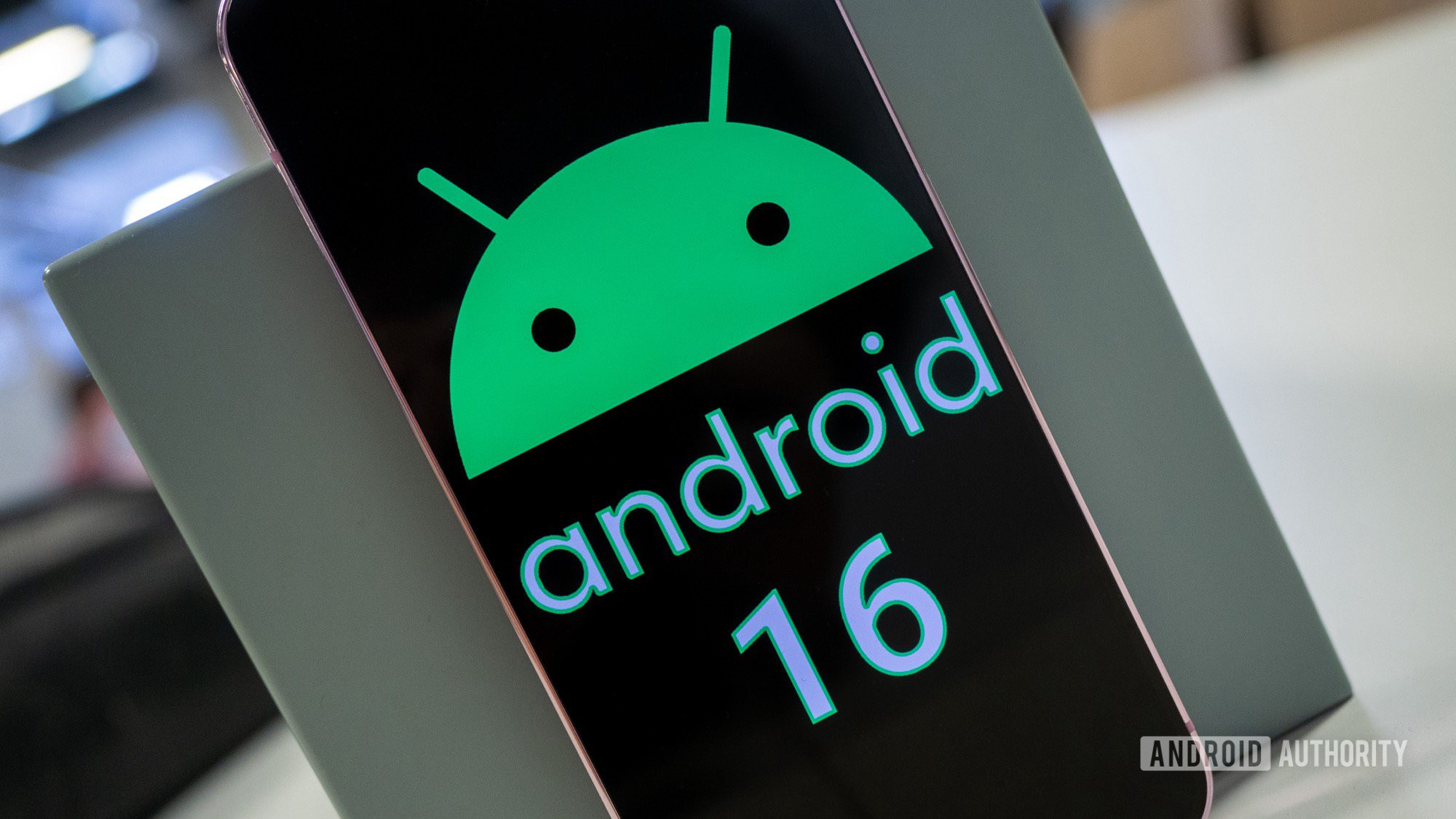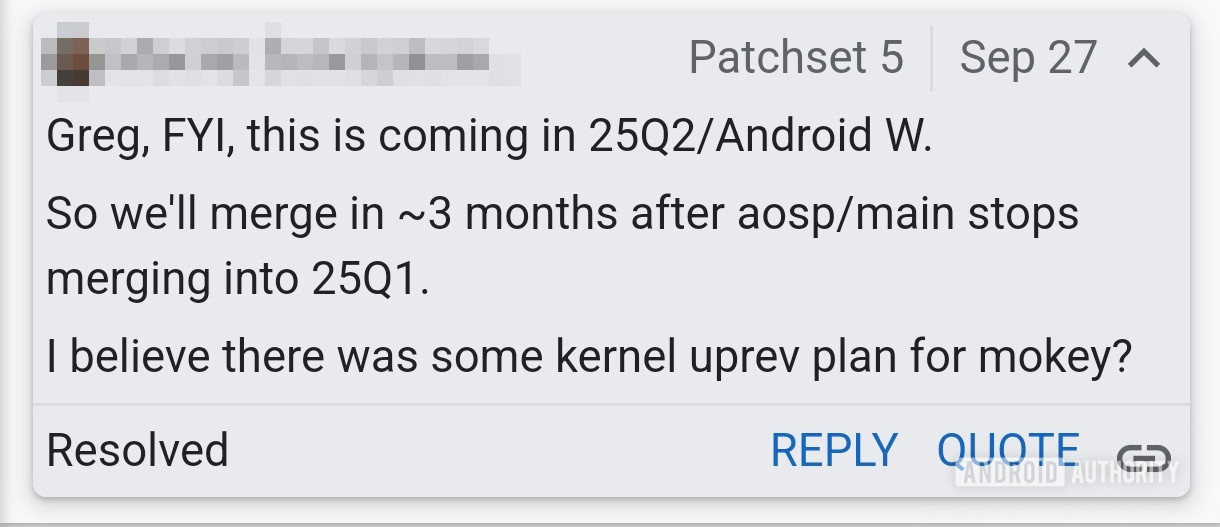Affiliate links on Android Authority may earn us a commission. Learn more.
Google may release Android 16 much earlier than expected
Published onSeptember 30, 2024

- Google may be planning to release Android 16 in Q2 of 2025.
- This would be unusual for Google, which usually releases major Android versions in August, September, or October.
- The release date of Android 16 hasn’t been confirmed yet, though.
Without fail, Google releases a new version of Android every year. This year’s version is Android 15, and its source code went public back at the beginning of the month. If you look back at the history of Android version releases, you’ll find that Google typically schedules these major releases for Q3 or Q4 of a given year. Google now looks to be significantly moving up Android’s release cycle, as evidence suggests it could launch Android 16 sometime in Q2 of 2025.
Google has typically released major new Android versions during the months of August, September, or October. Android 15, for example, arrived just earlier this month. Last year’s Android 14 update came out in early October. Meanwhile, 2022’s Android 13 update showed up in August. You have to go back to 2012’s Android 4.1 Jelly Bean release to find an Android version that didn’t land in August, September, or October.
| Android Version | Code-name | Release Date |
| Android 15 | Vanilla Ice Cream | September 3, 2024 |
| Android 14 | Upside Down Cake | October 4, 2023 |
| Android 13 | Tiramisu | August 15, 2022 |
| Android 12 | Snow Cone | October 4, 2021 |
| Android 11 | Red Velvet Cake | September 8, 2020 |
| Android 10 | Quince Tart | September 3, 2019 |
| Android 9 | Pie | August 6, 2018 |
| Android 8.0 | Oreo | August 21, 2017 |
| Android 7.0 | Nougat | August 22, 2016 |
| Android 6.0 | Marshmallow | October 5, 2015 |
| Android 5.0 | Lollipop | November 12, 2014 |
| Android 4.4 | KitKat | October 31, 2013 |
| Android 4.1 | Jelly Bean | July 9, 2012 |
| Android 4.0 | Ice Cream Sandwich | October 18, 2011 |
| Android 3.0 | Honeycomb | February 22, 2011 |
| Android 2.3 | Gingerbread | December 6, 2010 |
| Android 2.2 | Froyo | May 20, 2010 |
| Android 2.0 | Eclair | October 27, 2009 |
| Android 1.6 | Donut | September 15, 2009 |
| Android 1.5 | Cupcake | April 27, 2009 |
| Android 1.1 | February 9, 2009 | |
| Android 1.0 | September 23, 2008 |
Although the exact date changes each year, Android releases happen on a fairly predictable yearly cycle that gives Google enough time to plan, implement, and test whatever features and APIs it want to launch in a given update. Any changes it doesn’t have enough time for or runs out of time to implement in a given release are punted forward to the next one — rinse and repeat.
Thanks to better tooling, more robust infrastructure, and improvements to the platform architecture, Google has made it easier over the years to develop, test, and distribute new Android versions. However, one aspect of Google’s development process remained the same since Android’s beginning: the way its platform developers deal with AOSP branches.
Earlier this year, though, Google finally moved Android to a trunk-based development model, with the goal to improve platform stability. Under Google’s trunk stable project, its Android developers work on a single, unified internal “main” branch and use flagging to determine what features and APIs are enabled in a particular build they push out. This model has already resulted in some interesting changes, and it seems that it’s also enabled Google to push out new changes much faster than before. In fact, Google may have decided to release Android 16 earlier than usual because it’s so confident in this new development process.
While I was pouring over the Compatibility Definition Document (CDD) for Android 15, I noticed that Google twice referred to “25Q2” as the next release of Android. The reason this caught my attention is because under the normal release cycle, we’d be expecting the next version of Android more in 25Q3.
This isn’t widely known, but ever since Google released Android 14 QPR2 in March — Android’s first trunk stable release — the company has internally started to use dates to reference Android releases. Android 14 QPR2, for example, was known internally as 24Q1 while Android 14 QPR3 was called 24Q2. Android 15 is 24Q3 while the upcoming Android 15 QPR1 release is referred to as 24Q4.
With that context in mind, we return to the references to “25Q2” in the CDD as well as in several AOSP patches spotted by developer teamb58. Over the last few weeks, several Google engineers have left comments in AOSP that further suggest 25Q2 will be the next major release of Android. The first comment was left on a patch that adds a minimum Linux kernel version requirement to “Android W” (which some Googlers still use to refer to Android 16 even though it’s been decided to change the codename to “baklava”). The comment states that this change will be coming in “25Q2/Android W” which is why it won’t be merged until after the 25Q1 release is frozen in ~3 months.

The next piece of evidence can be found in a patch that implements a new API in the Bluetooth stack. The patch hasn’t been merged yet because the 24Q4 release “won’t allow any API change.” This makes sense as 24Q4 is Android 15 QPR1 and API changes are only allowed in major Android releases. Thus, the patch is being deferred to the “25Q2 window (i.e. after 25Q1 is cut).” Similarly, the third piece of evidence also mentions how API changes can’t be landed until the 25Q2 edition.
If 25Q2 were simply Android 15 QPR3, then it wouldn’t make sense for Google to push API changes in the release. Google makes a commitment to app developers not to introduce any breaking changes or any new APIs without bumping the SDK version. That’s why you never see any new app-facing system behaviors or API changes in QPRs, and it’s why I believe that 25Q2 refers to Android 16 and not Android 15 QPR3. Speaking to a source, my hunch appears to be correct, as the next SDK version bump is targeted for 25Q2, while 25Q3 is referred to internally as a QPR.
If I’m correct that 25Q2 does refer to Android 16, then it implies that Google plans to release it in Q2 of 2025. Q2 refers to the months of April, May, and June, but Android releases in Q2 typically happen in June. I would be surprised if Google releases Android 16 in April or May considering we haven’t even started the developer preview program yet, but it would be a pleasant surprise to have the update ready in time for Google I/O. At the very least, an earlier release would ensure that next year’s Pixel phones won’t launch with last year’s version of Android, like how the Google Pixel 9 series arrived with Android 14 instead of Android 15.